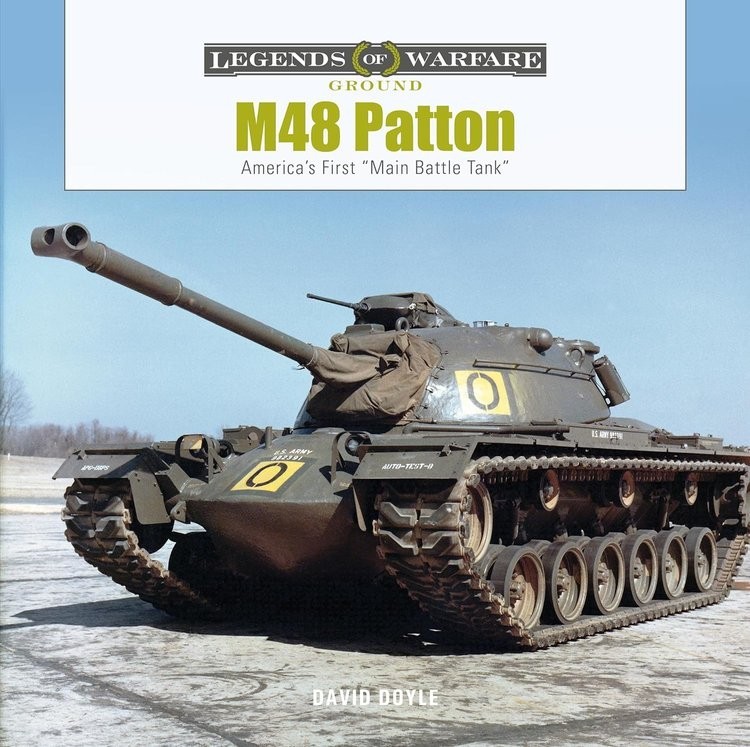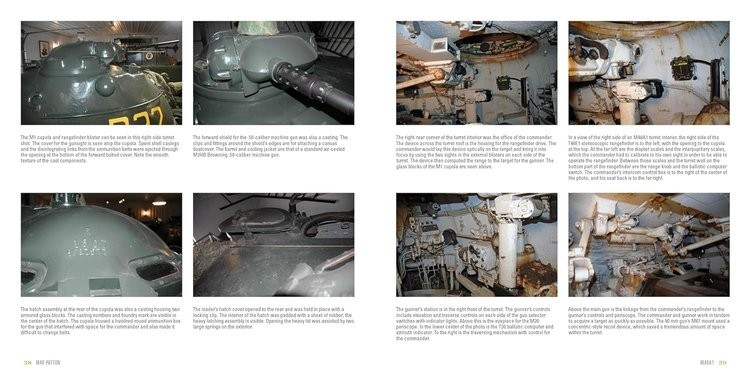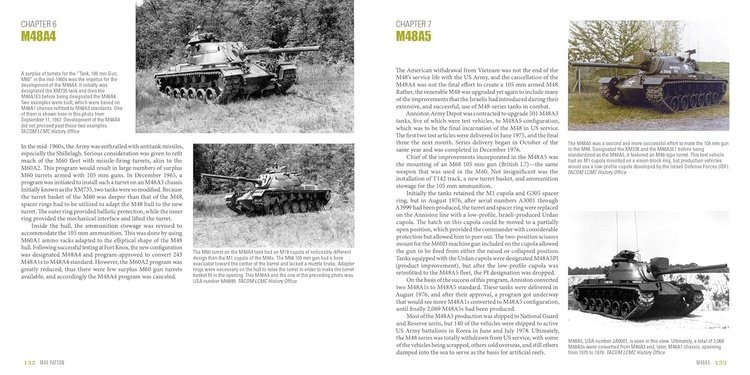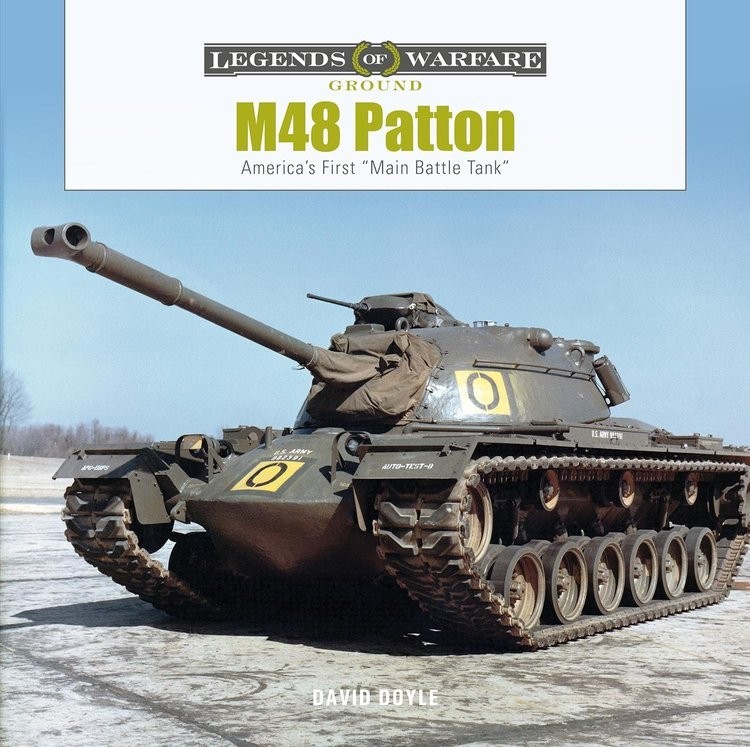Introduction
M48 Patton: America's First "Main Battle Tank" is a new title from David Doyle, part of Schiffer Publishing’s series "Legends of Warfare (Ground)." This pictorial book chronicles the M48 from its T48 prototype through the ultimate M48A5, and includes a chapter covering the flamethrower variant. A 9"x9" hardback of 144 semi-gloss pages, packed with 340 color or black-and-white photographs, it is catalogued with ISBN 978-0-7643-6783-9. Schiffer Publishing, Ltd. is the publisher and the book is also available at a discount from the author at DavidDoyleBooks.com.
Legends of Warfare is a series of books of standard size, layout, and range from 112 to 144 pages in length. They have a clean look to them and thus easy to read and learn from. Whether your interest is modeling, history or restoration, the focus is on the evolution and variant details of the M48 family.
The genesis of David Doyle Books began while restoring military vehicles, while at the same time working in a hobby shop. Thus, his keen emphasis on what so many people of those communities value about his work.

Contents
Why do you buy books about tanks? For technical research? Ideas to model? Memories of being a crewmember? Because the subject is cool? Regardless, this book should satisfy any of the above. While the author includes a great deal of technical information, this is predominately a visually oriented book. I have only crawled around on display tanks and yet the volume of photos in the gallery seems like almost every practice vantage point is covered across one variant or another. Modelers should be able to verify almost any question they have about the tank technically, and the wealth of M48s in the combat zone increases the value of the book in my eyes.
M48 Patton: America's First "Main Battle Tank" is told through seven chapters and an Introduction:
1. T48/M48 (23 pages)
2. M48A1 (12 pages)
3. M48A2/M48A2C (14 pages)
4. Flame Tanks (6 pages)
5. M48A3 (67 pages)
6. M48A4 (1 page)
7. M48A5 (12 pages)
A brief introduction summarizes the need to replace the M26 Pershing and the progression from that Second World War tank through the M46 and M47 to the M48. Brief though it may be, it offers the specifications, characteristics, and approval dates of the Ordnance Committee for the M48. It even provides a bit of trivia concerning a railroad locomotive manufacturer's participation in tank production. Noted are the corporations and plant locations of production sites. Throughout the chapters, design successes, shortcomings and outright failures are identified and discussed.
M48 development started as the T48. Mr. Doyle identifies and explains a variety of obvious characteristics, i.e., a 90mm gun, hemispheric turret, and points out subtle points, e.g., driver's hatch size, commander cupola, gun blast defector. Many photos are of T48s in various stages of design and assembly inside of factories, including "you-don't-see-that-everyday" images of tank chassis turned over by powerful rotary jigs. A sampling of other images I find particularly interesting:
- T48 awash during deep-fording experiment
- Climbing a steep slope
- Jettisonable rack for 55-gallon fuel drums
- Prepping an upside-down M48 for re-engineering with shot blasting
- Reconditioning hulls with no tops and fresh white interiors
- M87A1 mount with 90 mm Gun M41 being moved around factory
- Up-close look at wheel-less suspension and shock absorbers.
Beyond those images are dozens of other detail looks at items near and dear to modelers:
- Headlight brush guards
- Exhaust pipes for personnel heaters (I always wondered what those are)
- Early-style commander's hatch with bulge
- Mount for .50-caliber with gun dismounted
- Flat engine deck
- Stowage boxes.
Page 30 begins the chapter M48A1 which introduces the Tank, 90 mm Gun, M48A1 in Army parlance, and it quickly introduces us to the M1 commander's cupola, one of the iconic features of US MBTs. Once again, for those of us interested in such minutia, we learn of the designation of the new machine gun sighting equipment and periscope changes, and the date and Minutes number of Ordnance Technical Committee's new nomenclature. Other important tank developments focused upon are the increase to five track-support rollers, a larger driver hatch, "Jettison Fuel Tank Kit M48A1", cutting back of some front fenders, searchlights, dozer blades (and corresponding noticeable trim of the vehicle), external telephones, and T97 rubber chevron tracks.
As will continue through the book, other details noted are tank numbers and foundry marks, smooth texture of the castings, exhaust shroud to protect the gun travel lock, engine intake grills, shock absorber bump stop, and interior views of the tank. In those are identified components for specific compartments, which the author identifies and discusses items, e.g., in the turret such as rangefinders, diopter and interpupillary scales, linkages, and a variety of mechanisms, the recoil system for the 90 mm gun, selector switches, and many other equipment components. For the driver, throttle, fire extinguishing system, magneto control on the instrument panel, auxiliary generator. Considering a recent site thread about modeling interiors, this level of detail will no doubt be exciting to many modelers.
M48A2/M48A2C focuses on significant changes to rectify M48 shortcomings. A major change was the powerplant and transmission, which created an obvious new look to the M48, as well as other modifications, i.e., changes to the return-rollers and track-tensioning idlers occurred. Less obvious changes centered upon the suspension and turret traverse, sighting system, mudguard shapes and outriggers. Precise detail includes identifying the redesign of cooling and exhaust louvers - whether they tilted inward or outward, and at what angle. Particular brackets and fittings are mentioned.
More interesting photos include the method of loading M48s onto railcars. Technical eye-catchers include applique' armor and fitting the M48A2 with guided antitank missiles. We now find the M48 in Vietnam and see field modifications.
Ever hear of the M67? That was Ordnance's designation for the M48 flame thrower tank. Flame Tanks is a seven-page chapter which describes the tank with the same detail as the previous M48s.
The big show is M48A3, 67 pages worth of technical and operational parsing of this significant version. The text and photos are supported with line art of important changes, e.g., new cupola, modified new cupolas, front fenders. Dozens of high-quality color photos from Vietnam dominate this chapter:
- Tanks at rest
- Under transport
- In action
- As ad-hoc gunboat
- Damaged and destroyed
- Cutting away damaged steel in the field
- Field modifications
- Covered in red or yellow dust
- Blowing out mud from underneath a mired M48 with C4!
What do you want to see? You may find it here. We are treated to several detail photos of the AN/VSS-1 xenon searchlight and mounting brackets.
Finally, M48A4 covers the idea of putting an M60 turret on the M48, then we delve into the ultimate tank of the series, the big-gun M48A5. As previous chapters, the chief improvements are noted, as are bureaucratic points of interest.
There is no wrap-up summary, the book ending in with a full page photo of my old M48A5 buddy on display out in Oklahoma.
If you are seeking a comprehensive history of the M48 in use around the world, this book only covers American Pattons, and a few serving with ARVN (Army of the Republic of Vietnam), with mention of one or two other armies.
Photographs and Graphics
I did not count the advertised 340 color or black-and-white photographs but would not be surprised if there are a few more. The gallery is excellent, many being professionally exposed. Even amateur "grab shots" or "in-action" exposures are clear and well developed. If there are any that a fuzzy, they did not leave an impression. There are a few with deteriorating color, something common to Kodak films of the 1950s-70s, i.e., Kodak Kodacolor.
Subjects include M48s in production, in service, in action, and on display. The several display M48s were apparently photographed with modelers in mind, noting the quality of US casting resulting in a smooth armor texture. Ever wonder how many hinges should be on each driver periscope cover? Mud and dust patterns? Crew stowage tastes? Photographic evidence is provided.
Tables
Only two tables are included, providing easily digested data.
M48 General Data (with qualifiers) for the M48-M48A5 lists:
- Weight
- Length
- Width
- Height
- Crew
- Armament
- Maximum Speed
- Fuel capacity
- Range
- Electrical
- Fuel
- Turning radius
Engine Data: Gasoline vs Diesel:
- Engine make/model
- Number/arrangement of cylinders
- Cubic-inch displacement
- Horsepower
- Torque
- Governed speed




Conclusion
M48 Patton: America's First "Main Battle Tank" is a wonderful pictorial book from David Doyle Books. While it only covers American M48s, it affords modelers and historians an exceptional visual research for the study of the M48-series. Interesting historical information is included. The gallery of images is excellent.
I think that for what this book offers, it is well worth the $24.99 price. I am highly impressed with this book and look forward to my next title from David Doyle Books. Highly recommended.
Please remember to mention to retailers, David Doyle Books, and Schiffer Publishing that you saw this book here - on Armorama.



























